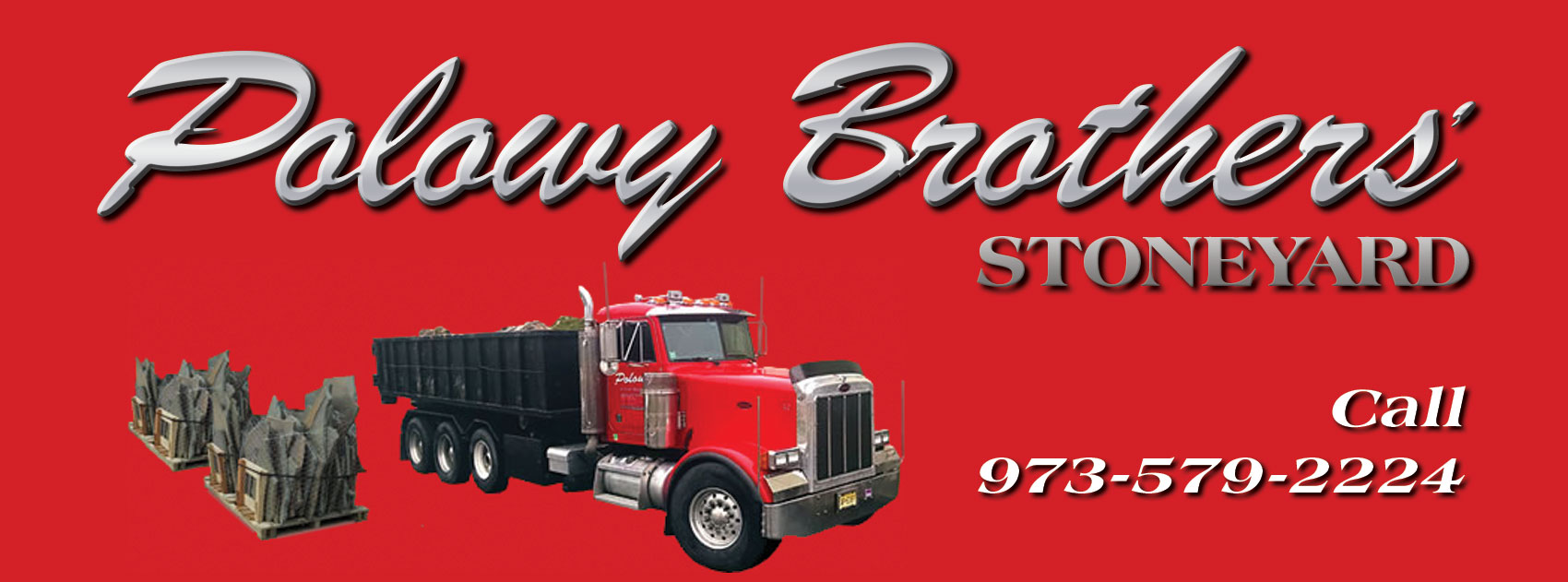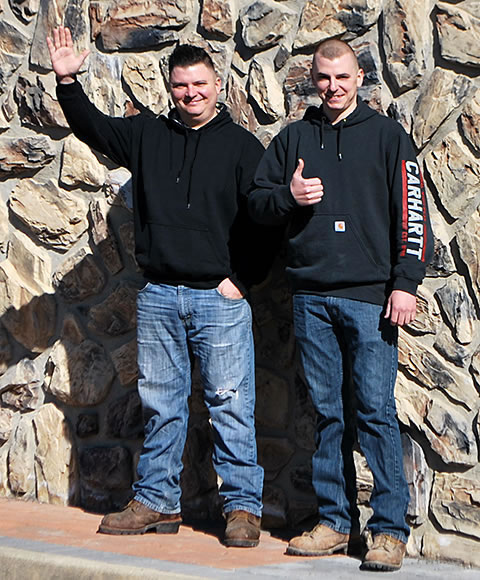| Arch |
— |
A curved stone structure resting on supports at both extremities used to sustain weight, to bridge or roof an open space. |
| Argillite |
— |
A compact sedimentary rock composed mainly of clay and aluminum silicate minerals. |
| Ashlars |
— |
Masonry having a face of square or rectangular stones, either smooth or textured. |
| Basalt |
— |
A dense-textured (aphanitic), igneous rock relatively high in iron and magnesia minerals and relatively low in silica, generally dark grey to black, and feldspathic; a general term in contradistinction to felsite, a light-colored feldspathic and highly siliceous rock of similar texture and origin. |
| Bluestone |
— |
A dense, hard, fine-grained, commonly feldspathic sandstone or siltstone of medium to dark or bluish-grey color that splits readily along original bedding planes to form thin slabs. A variety of flagstone, the thin relatively smooth-surfaced slabs being suitable for use as flagging. Quarried in eastern New York and Pennsylvania and in western New Jersey, but similar stones that occur elsewhere may be included. Can be split and used as flagging. |
| Brownstone |
— |
A sandstone of characteristic brown or reddish-brown color that is due to a prominent amount of iron oxide, as interstitial material. |
| Building Stone |
— |
Rock material in its natural state of composition and aggregation as it exists in the quarry and is usable in construction as dimension building stone. |
| Bullnose |
— |
Convex rounding of a stone member, such as a stair tread. |
| Calcarenite |
— |
Limestone composed predominantly of clastic sand-size grains of calcite, or rarely aragonite, usually as fragments of shells or other skeletal structures. Some calcarenites contain oolites (small, spherical grains of calcium carbonate that resemble roe) and may be termed oolite limestone. Calcareous sandstones, in which the calcium carbonate is present chiefly as bonding material, are not included in this category. |
| Calcite Limestone |
— |
A limestone containing not more than five percent of magnesium carbonate. |
| Calcite Streaks |
— |
White or milky-like streak occurring in stone. It is a joint plane usually wider than a glass seam, has been re-cemented by deposition of calcite in the crack, and is structurally sound. |
| Chamfer |
— |
To bevel the junction of an exterior angle. |
| Cobblestone |
— |
Natural rounded stone, large enough for use in paving; commonly used to describe paving blocks, usually granite, generally cut to rectangular shapes. |
| Coping |
— |
Flat stone used as a cap on freestanding walls. |
| Coquina |
— |
Limestone composed predominantly of unaltered shells or fragments of shells loosely cemented by calcite, generally very coarse-textured with a high porosity. The term has been applied principally to a very porous shell rock of Eocene age that has been quarried in Florida. |
| Cornerstone |
— |
Stone forming a part of a corner or angle in a wall. In addition, a stone laid at the formal inauguration of the erection of a building, not necessarily at a corner, usually incorporating a date or inscription. |
| Coursed Veneer |
— |
Achieved by using stones of the same or approximately the same heights. Horizontal joints run the entire length of the veneered area. Vertical joints are constantly broken so that no two joints will be over one another. |
| Crack |
— |
Break, split, fracture, fissure, separation, cleavage, or elongated narrow opening, however caused, visible without magnification to the human eye and extending from the surface into the stone that must extend through the grain or matrix. |
| Crowfoot (Styolite) |
— |
Dark grey to black zigzag marking occurring in stone. Usually structurally sound. |
| Crystalline Limestone |
— |
Limestone, either calcitic or dolomitic, composed of interlocking crystalline grains of the constituent minerals and of phaneritic texture; commonly used synonymously with marble and thus representing a re-crystallized limestone; improperly applied to limestones that display some obviously crystalline grains in a fine-grained mass but which are not of interlocking texture and do not compose the entire mass. |
| Cut Stone |
— |
Stone fabricated to specific dimensions. |
| Dacite |
— |
Fine-grained, extrusive (volcanic) rock, intermediate in color and composition between basalt and rhyolite. |
| Defect |
— |
Features, which affect or have the potential of affecting the structural soundness of building stone, or may affect the durability of the building stone. Sometimes used for visual features such as xenoliths or veins. |
| Dimension Stone |
— |
Natural building stone that has been selected, trimmed or cut to specified or indicated shapes or sizes with or without one or more mechanically dressed surfaces. |
| Dolomitic Limestone |
— |
Limestone rich in magnesium carbonate, frequently somewhat crystalline in character, found in ledge formations in a wide variety of color tones and textures. Its crushing and tensile strengths are greater than the oolitic limestones and its appearance shows greater variety in texture. |
| Dressed, Hand Dressed |
— |
Cutting of rough chunks of stone by hand to create a square or rectangular shape. A stone, which is sold as dressed stone generally, refers to stone ready for installation. Sometimes called scabbling. |
| Drip |
— |
Recess cut under a sill or projecting stone to throw off water, preventing it from running down the face of the wall or other surface, such as a window or door. |
| Dry Wall |
— |
Dry wall is a stone wall that is constructed one stone upon the other without the use of any mortar. Generally used for retaining walls. |
| Durability |
— |
Measure of the ability of natural building stone to endure and to maintain its essential and distinctive characteristics of strength, resistance to decay, and appearance, with relation to a specific manner, purpose, and environment of use. |
| Efflorescence |
— |
Crystalline deposit appearing on stone surfaces typically caused by soluble salts carried through or onto the stone by moisture, which has sometimes been found to come from brick, tile, concrete blocks, cement, mortar, concrete, and similar materials in the wall or above. |
| Face |
— |
Refers to the exposed portion of stone. The word “face” can also be used when referring to the edge treatment on various cutting stock materials. |
| Ferruginous |
— |
Limestone or sandstone containing a high proportion of iron oxide. |
| Fieldstone |
— |
Loose blocks separated from ledges by natural processes and scattered through or upon the regolith (“soil”) cover; applied also to similar transported materials, such as glacial boulders and cobbles. |
| Fines |
— |
Powder, dust, silt-size and sand-size material resulting from processing (usually crushing) rock. |
| Finished Stone |
— |
Building stone with one or more mechanically dressed surface(s). |
| Flagstone |
— |
Thin slabs of stone used for flagging or paving walks, driveways, patios, etc. It is generally fine-grained sandstone, bluestone, quartzite, or slate, but thin slabs of other stones may be used. |
| Fracture |
— |
A break in rock produced by mechanical failure. Fractures include faults and joints. |
| Freestone |
— |
Stone that may be cut freely in any direction without fracture or splitting. |
| Gauged, Gauging |
— |
Grinding process to make all pieces of material to be used together the same thickness. |
| Granite |
— |
Fine- to coarse-grained, igneous rock formed by volcanic action consisting of quartz, feldspar, and mica, with accessory minerals. Granite-type rocks include those of similar texture and origin. |
| Hand-cut Random Rectangular Ashlar |
— |
Pattern where all the stone is hand cut into squares and rectangles. Joints are consistent. Similar to sawed-bed ashlar in appearance. |
| Igneous |
— |
One of the three great classes of rock (igneous, sedimentary and metamorphic), solidified from molten state, as granite and lavas. |
| Joint |
— |
Space between stone units usually filled with mortar. |
| Jumper |
— |
In ashlar patterns, a piece of stone of higher rise than adjacent stones, which is used to end a horizontal mortar joint at the point where it is set. |
| Keystone |
— |
The last wedge-shaped stone placed in the crown of an arch regarded as binding the whole. |
| Limestone |
— |
Sedimentary rock composed of calcium carbonate; includes many varieties. Limestone that contain not more than 5% magnesium carbonate may be termed calcite limestone, as distinguished from those that contain between 5-40% magnesium carbonate (magnesium or dolomitic limestone), and from those that contain in excess of 40% as the mineral dolomite (dolostone, formerly known as the rock dolomite). Re-crystallized limestones are compact, dense, relatively pure microcrystalline varieties that are capable of taking a polish are included in commercial marbles. |
| Lintel |
— |
Block of stone spanning the top of an opening such as a doorway or window; sometimes called a head. |
| Masonry |
— |
Built-up construction, usually of a combination of materials set in mortar. |
| Metamorphism |
— |
Change or alteration in a rock caused by exterior agencies, such as deep-seated heat and pressure, or intrusion of rock materials. |
| Mortar Natural Cleft |
— |
Plastic mixture of cement, lime, sand, and water used to bond masonry units. |
| Natural Cleft |
— |
Generally pertains to stones, which are formed in layers in the ground. When such stones are cleaved or separated along a natural seam the remaining surface is referred to as a natural cleft surface. |
| Palletized |
— |
A system of stacking stone on wooden pallets. Stone that comes palletized is easily moved and transported by modern handling equipment. Palletized stone generally arrives at the job site in better condition than unpalletized material. |
| Pointing |
— |
Final filling and finishing of mortar joints that have been raked out. |
| Processing |
— |
Work involved in transforming building stone from quarry blocks to cut or finished stone. This includes primary sawing into slabs. It may also include both hand and mechanical techniques such as sawing, drilling, grinding, honing, polishing, and carving. |
| Projections |
— |
Pulling out of stones in a wall to give an effect of ruggedness. The amount each stone is pulled out can vary between 0.5 and 1.5 inches (1.3 to 3.8cm). Stones are either pulled out at the same degree at both ends or sometimes one end is pulled out, leaving the other end flush with the majority of the veneer. |
| Quarry |
— |
The location of an operation where a natural deposit of stone is removed from the ground. |
| Quartz |
— |
A silicon dioxide mineral that occurs in colorless and transparent or colored hexagonal crystals and in crystalline masses. One of the most common minerals, the chief constituent of sandstone. |
| Quartzite |
— |
Compact granular rock composed of quartz crystals, usually so firmly cemented as to make the mass homogeneous. The stone is generally quarried in stratified layers, the surfaces of which are unusually smooth. Its crushing and tensile strengths are extremely high; the color range is wide. |
| Quartzite Sandstone |
— |
Sandstone with a high concentration of quartz grains and siliceous cement. |
| Reveal |
— |
Depth of stone between its outer face and a window or door set in an opening. |
| Rise |
— |
Heights of stones, generally used in reference to veneer stone. |
| Rock |
— |
An integral part of the earth's crust composed of an aggregate of grains of one or more minerals. (Stone is the commercial term applied to quarry products.) |
| Rubble |
— |
Product term applied to dimension stone used for building purposes, chiefly walls and foundations, and consisting of irregularly shaped pieces, partly trimmed or squared, generally with one split or finished face, and selected and specified with a size range. |
| Sandstone |
— |
Sedimentary rock consisting usually of quartz, cemented with silica, iron oxide, or calcium carbonate. Sandstone is durable, has a very high crushing and tensile strength and a wide range of colors and textures. Varieties of sandstone are commonly designated by the kind and prominence of interstitial and bonding materials. |
| Sawed Edge |
— |
Clean-cut edge generally achieved by cutting with a diamond blade, gang saw, or wire saw. |
| Sawed Face |
— |
Finish obtained from the process used in producing building stone; varies in texture from smooth to rough and coincident with the type of materials used in sawing; characterized as diamond sawn, sand sawn, chat sawn and shot sawn. |
| Scabbling |
— |
Cutting of rough chunks of stone by hand to create a square or rectangular shape. A stone, which is sold as dressed stone generally, refers to stone ready for installation. Sometimes called Dressed or Hand-dressed. |
| Schist |
— |
Loose term applying to foliated metamorphic (recrystallized) rock characterized by thin foliae that are composed predominantly of minerals of thin platy or prismatic habits and whose long dimensions are oriented in approximately parallel positions along the planes of foliation. Because of this foliated structure, schists split readily along these planes and so possess a pronounced rock cleavage. The more common schists are composed of the micas and other mica-like minerals (such as chlorite) and generally contain subordinate quartz and/or feldspar of comparatively fine-grained texture; all graduations exist between schist and gneiss (coarsely foliated feldspathic rocks). |
| Serpentine |
— |
Hydrous magnesium silicate of igneous origin, generally a very dark green color with markings of white, light green or black. One of the hardest varieties of natural building stone. |
| Sill |
— |
Flat stone used under windows, doors, and other masonry openings. |
| Slab |
— |
Lengthwise cut of a large quarry block of stone produced by sawing or splitting in the first milling or quarrying operation. A slab has two parallel surfaces. |
| Snapped Edge, Quarry Cut, Broken Edge |
— |
Natural breaking of a stone either by hand or machine. The break should be at right angles to the top and bottom surfaces. |
| Split Face Stone |
— |
Stone on which the face has been broken to an approximate plane. |
| Stone |
— |
Sometimes synonymous with rock, but more properly applied to individual blocks, masses, or fragments taken from their original formation or considered for commercial use. |
| Stratification |
— |
Structure produced by deposition of sediments in beds or layers (strata), laminae, lenses, wedges, and other essentially tabular units. |
| Thin Stone |
— |
Cladding less than 2 inches (50mm) thick. |
| Thin Veneer |
— |
Dimensional allowance made for the inability of men and machines to fabricate a product of exact dimensions. |
| Tolerance |
— |
Fat stone used as the top walking surface on steps. |
| Tread |
— |
Non-load bearing facing of stone attached to a backing for the purpose of ornamentation, protection, or insulation. Veneer shall support no vertical load other than its own weight and possibly the vertical dead load of veneer above. |
| Veneer |
— |
Non-load bearing facing of stone attached to a backing for the purpose of ornamentation, protection, or insulation. Veneer shall support no vertical load other than its own weight and possibly the vertical dead load of veneer above. |
| Veneer Stone |
— |
Non-load bearing facing of stone attached to a backing for the purpose of ornamentation, protection, or insulation. Veneer shall support no vertical load other than its own weight and possibly the vertical dead load of veneer above. |


